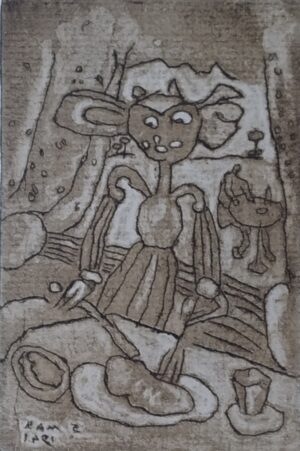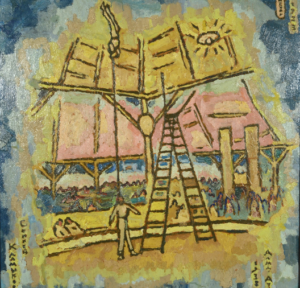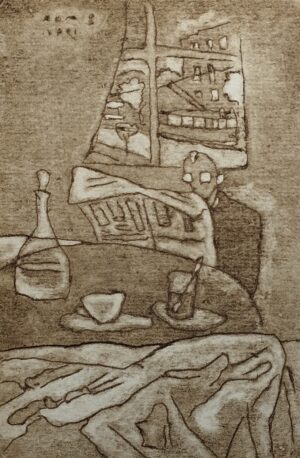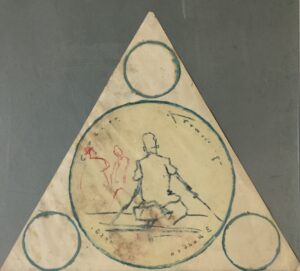Kalmykov Sergey
1891-1967
Kalmykov Sergey Ivanovich. Soviet and Kazakhstani artist, illustrator, decorator, writer; avant-garde artist, the only one of the masters of the Silver Age who survived until the end of the sixties. Kalmykov's works have no direct analogues in the history of world art. In the course of his creative activity Kalmykov developed an original style of painting, sometimes referred to as ‘fantastic expressionism’. Kalmykov is now considered one of the most important representatives of Russian avant-garde art, the author of more than one and a half thousand paintings, drawings, illustrations, theatre... далее
Kalmykov Sergey Ivanovich. Soviet and Kazakhstani artist, illustrator, decorator, writer; avant-garde artist, the only one of the masters of the Silver Age who survived until the end of the sixties. Kalmykov's works have no direct analogues in the history of world art. In the course of his creative activity Kalmykov developed an original style of painting, sometimes referred to as ‘fantastic expressionism’. Kalmykov is now considered one of the most important representatives of Russian avant-garde art, the author of more than one and a half thousand paintings, drawings, illustrations, theatre sets and literary texts. Sergei Ivanovich Kalmykov was born in Samarkand on 6 October 1891. Soon his family moved to Orenburg, where he studied at the gymnasium. In 1909-1910 he lived in Moscow, attended art school, then in St. Petersburg studied in the workshop of M. Dobuzhinsky and K.S. Petrov-Vodkin. Sergei Kalmykov said that one of his early works, in which he depicted red horses on the water in 1911, inspired Petrov-Vodkin to create his famous painting ‘Bathing a Red Horse’ (1912). In 1926, after the October Revolution, Kalmykov returned to Orenburg, where he worked as a decorator, decorated parades and demonstrations, gave lectures and continued to paint pictures. From 1926 to 1928 he was a member of the Orenburg branch of the AHRR (Association of Artists of Revolutionary Russia). In 1935, when censorship intensified and there were purges in the ranks of intellectuals, Sergei Kalmykov decided to move from Orenburg to Almaty. In 1935-1962 he worked as a theatre artist at the Kazakh State Academic Opera and Ballet Theatre named after Abai until his retirement. For Sergey Kalmykov art was not only the meaning of life, but also the way of existence. Everything that existed seemed to him as phenomena of Cosmic Genesis. He carried this solemn holiday in his soul all the time, that is why each of his works carries a powerful energy of joy and becomes a miracle. In parallel with the activity of a stage designer Kalmykov was engaged in easel painting and graphics. He often used improvised means, drew on scraps, geographical maps, wrapping paper. He was engaged in etching, monotype. Author of pictorial works: ‘Trees’ (1909), “Red Horses” (1911), “In the circus” (1924), “The Abduction of Europe” (1928), “Railway Station” (1930), “Fantastic Landscape with Red Rocks” (1938), “In the Park” (1944), “Lanterns at the theatre” (1945), “At the garden trellis” (1946), “Hippodrome” (1948), ’Street lamp. Evening Landscape’ (1949), “Water Pool” (1950), “At the Youth Spartakiade” (1951), “Gorge on the road to Medeo” (1952), “Serenade” (1959), “Allegory” (1964), “Opera House in the city of Almaty” (1947), “Autumn” (1961) and other numerous works. After retirement in 1962 Kalmykov constantly experienced material problems, very poorly nourished (according to descriptions, being a vegetarian, he ate only bread and milk and did not eat hot food for months), but nevertheless continuously created more and more new works. Kalmykov often painted in the streets and parks of the city, especially after his retirement, and eventually became an urban legend because of his extravagant outfits and eccentric behaviour. Thus, one of his outfits was described as ‘a bright red beret, blue trousers with gold stripes and a cloak with tin cans sewn onto it, rattling as he walked’. Kalmykov died on 27 April 1967 in Almaty. According to the most rough calculations, Kalmykov left behind more than one and a half thousand works (drawings, graphics, painting) and about ten thousand pages of manuscripts. These manuscripts themselves are a kind of ‘samizdat’: stapled, stitched and bound books, generously illustrated. Without exception, all the texts are handwritten, each letter is a drawing, each page a complete composition. ‘Van Gogh and Degas Album’, “The Green Book”, “The Dove Book”, “The Boom Factory”, “Moon Jazz”, “A Thousand Compositions with Atomic Reflectors”. There are essays and art essays, philosophical musings and novels. The last entry, found in his diary, characterises his philosophy and attitude to life in the best possible way: ‘What is there any theatre for me? Or a circus? For me, all life is a theatre’. After the death of the artist in April 1967, due to the absence of heirs, by the decision of a special commission of the Ministry of Culture of Kazakhstan, the personal archive of Sergei Kalmykov was transferred for storage in the Central State Archive. His paintings are kept in the A. Kasteev State Museum of Arts of the Republic of Kazakhstan, the Orenburg State Museum (Russian Federation), in private collections. скрыть
Works of the artist
 Kalmykov Sergey
Kalmykov Sergey Kalmykov Sergey
Kalmykov Sergey Kalmykov Sergey
Kalmykov Sergey Kalmykov Sergey
Kalmykov Sergey Kalmykov Sergey
Kalmykov Sergey Kalmykov Sergey
Kalmykov Sergey